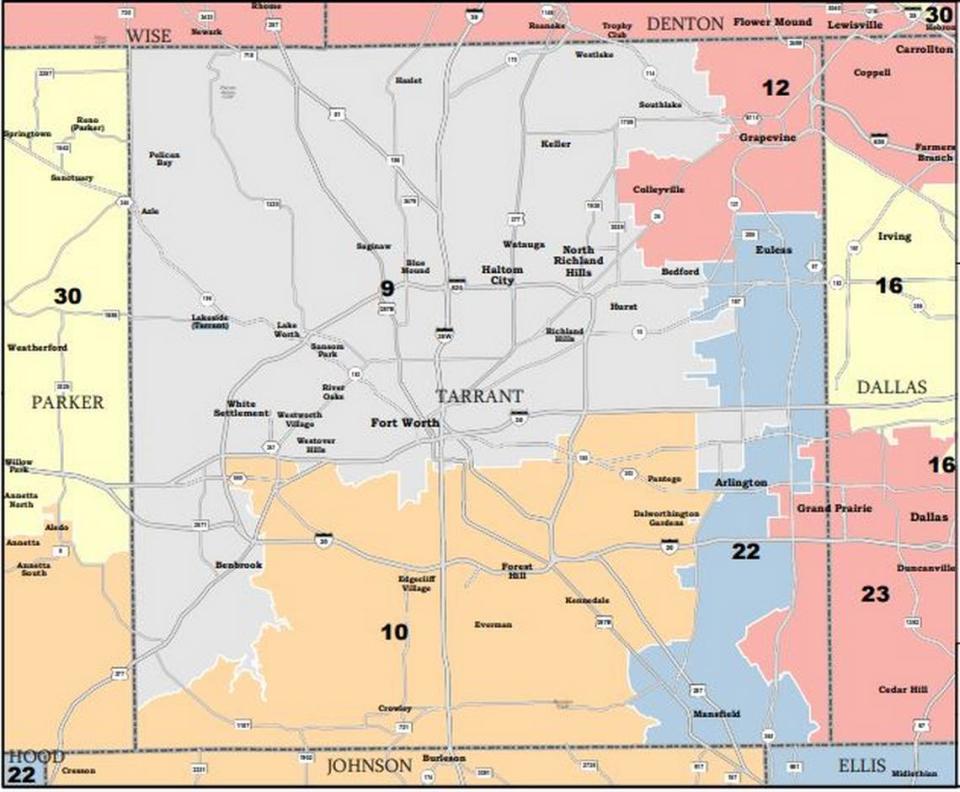Texas lawmakers near the finish on redistricting. Here’s how Fort Worth is affected.
- Oops!Something went wrong.Please try again later.
Texas lawmakers are nearing the end of the redistricting process in the final days of the special legislative session.
Every 10 years the state legislators are tasked with creating new maps for the Texas’ House, Senate, State Board of Education and congressional districts, a process that ultimately affects Texans’ representation in government.
Texas lawmakers have completed drawing three of the four maps they’re tasked with crafting. The boundaries for the state House, Senate and State Board of Education were sent to Gov. Greg Abbott for approval Friday.
The House and Senate have different versions of the congressional map, so the map was sent to a committee of lawmakers from both chambers to work out the differences early Sunday. Under both proposed maps, North Texas did not gain one of the state’s two new congressional seats, with the districts instead going to Harris and Travis county areas.
One of the changes made in the House would move several Fort Worth neighborhoods, including White Lake Hills, Meadowbrook, Handley and Ryanwood, out of Republican Rep. Kay Granger’s Congressional District 12 into Congressional District 33, which is represented by Democratic Rep. Marc Veasey. The change effects less than 50,000 people, Rep. Chris Turner said on the floor Saturday.
By Sunday night, a compromise version of the congressional map had been filed.
Here’s how the maps headed to Abbott affect districts in the Fort Worth-area.
Texas Senate Districts
One of the biggest changes to Tarrant County’s state Senate seats is in Senate District 10, a seat held by Democratic Sen. Beverly Powell of Burleson. The seat that has flipped between Democrats and Republicans in the past would be more likely to vote Republican under the new boundaries, stretching the district outside of Tarrant County and into rural counties. Opponents of the change have criticized the redrawn district for diluting the vote of people of color who live in the district.
House Democrats from Tarrant County tried to restore the district through floor amendments, but were unsuccessful in altering the new boundaries. Typically the House and Senate do not change each other’s maps.
“There are things much more important than tradition, such as voting rights and fair representation,” Powell said in a tweet.
Tarrant County is divided between five Senate districts under the proposed map, with Senate District 9, held by Rep. Kelly Hancock, R-North Richland Hills, covering nearly half of the county. A portion of Dallas Democrat Royce West’s Senate District 23 seat would fall in the county’s southeastern edge.

Texas House Districts
Tarrant County would have 11 representatives in the state House, the same as it does currently.
The House map headed to Abbott includes a House District 92 seat in east Tarrant County that is more likely to flip blue than as currently drawn, according to an analysis of election data. In the new map, much of Bedford, Euless and Hurst are cut out of the district currently represented by Republican Rep. Jeff Cason of Bedford.
House District 90 represented by Democratic Rep. Ramon Romero Jr. of Fort Worth sees a decrease in the number of Black and/or Hispanic voters under the new map. The U.S. Supreme Court previously found that the district was racially gerrymandered.
Most of Fort Worth would be divided between House Districts 90, 93, 95, 97 and 99.
Statewide, the map decreases the number of districts where Hispanic and Black voters make up the majority voters, and increases the number of districts where white voters make up the majority, according to The Texas Tribune.

State Board of Education Districts
Tarrant County would continue to be split between State Board of Education Districts 11 and 13 under the version of the map headed to Abbott for approval. The bulk of the county (71%) would be within District 11, which covers much of Tarrant County’s suburban areas. District 13 includes part of Fort Worth, as well as much of Dallas County.
District 11 would likely continue to be a Republican district under the proposed map, and District 13 would likely remain blue, according to an 2020 election data for the U.S. Senate race.
The population of District 11 as proposed is about 54% Anglo, 23% Hispanic, 13% Black and 8% Asian with the proposed boundaries. The population of District 13 is roughly 19% Anglo, 48% Hispanic, 29% Black and 4% Asian.


